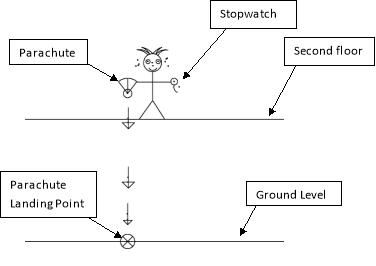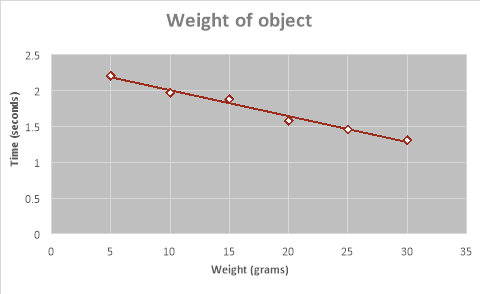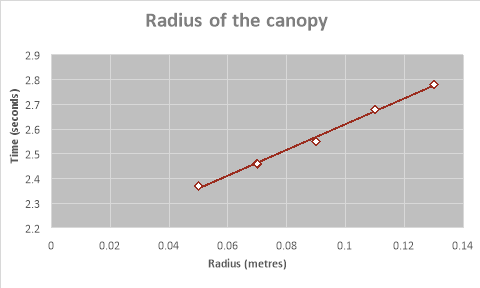The Physics of a Parachute
| ✅ Paper Type: Free Essay | ✅ Subject: Physics |
| ✅ Wordcount: 1944 words | ✅ Published: 11th Sep 2017 |
The parachute is an effective tool for enhanced safety, although it is widely utilized by adrenaline seekers for enjoyment.
Gravity is perhaps the most crucial force acting upon the parachute, because without which a parachute would not be needed. Gravity is applied to a mass indiscriminate of its size or shape.  is the speed at which a mass will accelerate due to gravity through the air, with no opposing forces acting upon it.
is the speed at which a mass will accelerate due to gravity through the air, with no opposing forces acting upon it.
Air Resistance is the whole reason why a parachute works. The air is undisturbed until a mass passes through it, when that mass passes through air it is effectively the same as air flowing past a mass. When air cannot travel smoothly past a body it is called drag, when drag is applied to a mass, it slows the object and or the flow of air. When a parachute is opened, air is trapped under the fabric and is forced in a swirl in uneven patterns, when air swirls it increases drag and decreases the speed of a body. When air swirls it also reduces its efficiency, a parachute when passing through the air compromises this and depending on how large the physical size of the parachute it will slow the acceleration of the mass considerably.
According to Dictionary.com, terminal velocity is “the constant speed that a freely falling object eventually reaches when the resistance of the medium through which it is falling prevents further acceleration.”
This means that the terminal velocity of a falling mass occurs in free fall when a zero acceleration is felt, this meant that the mass doesn’t accelerate anymore because the forces, air resistance and gravity, air resistance will eventually balance the masses weight and therefore will fall at a constant rate, this is terminal velocity. More simply put, terminal velocity is the fastest velocity that an object will fall due to gravity.
The equation for terminal velocity is:
The physical properties of wind resistance are obvious. When the parachute is opened, the drag is significantly increased, this is due to the massively increased area that:
- As the size of the canopy increases, the time taken for the parachute to reach the ground will proportionally increase.
- As the mass of the object increases or decreases, the time taken for the parachute to reach the ground will increase or decrease consecutively.
- If the length of the suspension lines is increased, the time taken for the parachute to reach the ground will increase to a curtain point, then level out.
|
Variables |
Changes made |
Time (seconds) |
Average (seconds) |
|||
|
Trial 1 |
Trial 2 |
Trial 3 |
Trial 4 |
|||
|
Weight |
0.01kg |
1.3 |
1.8 |
1.6 |
1.2 |
1.475 |
|
0.02kg |
1.9 |
2.4 |
2.2 |
2.5 |
2.250 |
|
|
0.03kg |
2.2 |
2.9 |
2.5 |
3.0 |
2.650 |
|
|
Radius of parachute |
0.05m |
1.1 |
1.3 |
1.5 |
1.6 |
1.375 |
|
0.10m |
1.6 |
1.5 |
1.9 |
1.7 |
1.675 |
|
|
0.15m |
1.8 |
1.5 |
1.3 |
1.8 |
1.600 |
|
|
0.20m |
1.5 |
1.6 |
1.9 |
2.6 |
1.900 |
|
 Firstly, a parachute was created using light cloth and string. The diagram below is a representation of the design created.
Firstly, a parachute was created using light cloth and string. The diagram below is a representation of the design created.
Next, the appropriate mass was attached to the parachute via the suspension lines. The person was positioned on the second floor. The height of the drop was then measured, the preliminary test data was collected.
The following results were obtained through experimentation:
|
Variable |
Changes made |
Time (seconds) |
Average (seconds) |
|||
|
Weight (Kilograms) |
Trial 1 |
Trial 2 |
Trial 3 |
Trial 4 |
||
|
0.005 |
2.03 |
2.25 |
2.22 |
2.34 |
2.21 |
|
|
0.01 |
1.96 |
1.98 |
1.88 |
2.04 |
1.97 |
|
|
0.01 |
2.07 |
1.85 |
1.83 |
1.75 |
1.88 |
|
|
0.02 |
1.32 |
2.04 |
1.41 |
1.53 |
1.58 |
|
|
0.025 |
1.42 |
1.50 |
1.47 |
1.46 |
1.46 |
|
|
0.03 |
1.56 |
1.25 |
1.03 |
1.41 |
1.31 |
|
|
Radius of Parachute (Metres) |
||||||
|
0.05 |
2.36 |
2.37 |
2.40 |
2.33 |
2.37 |
|
|
0.07 |
2.45 |
2.42 |
2.48 |
2.50 |
2.46 |
|
|
0.09 |
2.54 |
2.56 |
2.52 |
2.58 |
2.55 |
|
|
0.11 |
2.64 |
2.69 |
2.71 |
2.68 |
2.68 |
|
|
0.13 |
2.72 |
2.83 |
2.80 |
2.75 |
2.78 |
|
|
Length of suspension lines (Metres) |
||||||
|
0.05 |
2.20 |
2.52 |
2.58 |
2.62 |
2.48 |
|
|
0.07 |
2.25 |
2.25 |
2.24 |
2.16 |
2.23 |
|
|
0.09 |
2.48 |
2.45 |
2.10 |
2.28 |
2.32 |
|
|
0.10 |
2.35 |
2.27 |
2.45 |
2.52 |
2.40 |
|
|
0.12 |
2.56 |
2.31 |
2.23 |
2.34 |
3.36 |
|


The data was collected and has been analyzed. Patterns have been produced through the previous results. The results have shown that the mass of the object affects the speed at which the parachute falls. As the mass increases, the time shortens proportionally, this demonstrates that the relationship that occurs.
The inability to access precise measuring equipment affected the results, as a consequence the results are inconsistent, although the majority of the results were close to the expected time. The
As with all results, some of the above results were inconsistent. The results were as expected for the mass and the mass and the radius, the length of the suspension lines however was in consistent with the hypothesis. As the experiment progressed, it became clearer that they were
References
Basic Assumptions of Modern Physics Not Falsifiable. (2012, 7 13/10/2016). Retrieved from The world as computation: https://claesjohnsonmathscience.wordpress.com/2012/07/02/is-modern-physics-falsifiable/
Bourne, M. (2016, 2 29/10/2016). Differentiation (Finding Derivatives). Retrieved from Interactive Mathematics: http://www.intmath.com/differentiation/differentiation-intro.php
Christian, D., & Crossley, W. (1987). Essential Physics (Book one). Sydney: Sapphire Books.
Davies, P., & Harding, J. (Physics around you). 1991. Melbourne: Longman Cheshire.
Dictionary.com. (2017). Terminal velocity. Retrieved from Dictionary.com: http://www.dictionary.com/browse/terminal-velocity
Duncan, T. (2008). Physics (Fourth Edition). London: Hodder Education.
Gaze, T., Lindsay, I., Maddern, D., & Stelzer, T. (2006). Physics a Contextual Approach. Port Melbourne.
Hall, N. (2015, 5 11/20/2016). conversion of momentum. Retrieved from NASA: https://www.grc.nasa.gov/www/k-12/airplane/conmo.html
How does placing objects in liquids affect the mass? (2012). Retrieved from Newtonian Mechanics: http://physics.stackexchange.com/questions/19696/how-does-placing-objects-in-liquids-affect-the-mass
Hyper Physics. (2000, 8 21/10/2016). The laws of Newton. Retrieved from Hyper physics: http://hyperphysics.phy-astr.gsu.edu/hbase/newt.html
Maccaster, R. (1993). Physics. London: Stanley Thornes.
Richcard, W. G. (2001). New Century Physics. Melbourne : Oxford.
Skwirk online education. (2013). Law of Conservation of Energy. Retrieved from Skwirk online education: http://www.skwirk.com/p-c_s-4_u-308_t-756_c-2845/law-of-conservation-of-energy/nsw/law-of-conservation-of-energy/force-and-motion/energy
Teichroew, D. (1954, june 30). Statistical Analysis of Experimental Parachute Test Data. Retrieved from National Bureau of Standards : http://nvlpubs.nist.gov/nistpubs/Legacy/RPT/nbsreport3493.pdf
The Physics Classroom. (2016). Distance and Displacement. Retrieved from The Physics Classroom: http://www.physicsclassroom.com/class/1DKin/Lesson-1/Distance-and-Displacement
Workshop Tutorials for Physics. (n.d.). Mechanics activities. Retrieved from Workshop Tutorials for Physics: http://www.physics.usyd.edu.au/super/physics_tut/volume3/mechact.pdf
expected for the mass and the mass and the radius, the length of the suspension lines however was in consistent with the hypothesis. As the experiment progressed, it became clearer that the
Cite This Work
To export a reference to this article please select a referencing stye below:
Related Services
View allDMCA / Removal Request
If you are the original writer of this essay and no longer wish to have your work published on UKEssays.com then please click the following link to email our support team::
Request essay removal


